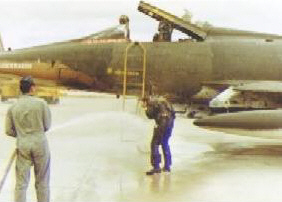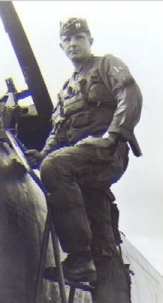Vietnam Veteran Fighting Back
Kermit "Kit" Fulton enjoyed excellent health until the Summer of 1997 when he began to experience difficulty swallowing. He underwent an endoscopy and was found to have narrowing of the mid esophagus without any mucosal abnormalities. Because of the appearance of extrinsic compression, a CT scan was performed, which showed a posterior mediastinal mass that was pressing against the esophagus. A biopsy was performed at the Madigan Army Hospital near Seattle on September 2, 1997. The pathologist diagnosed malignant mesothelioma. The Army Hospital sought a second opinion from Dr. Samuel P. Hammar, who confirmed the diagnosis.
Kit had fought in the Vietnam War as an air force pilot. He spent his highly decorated career dodging missiles, bombs, shrapnel and bullets. He wasn't about to go down in flames. Not without a fight.
Kit would have to fight back, however, without surgical resection as a defense. After speaking to his doctors, Kit understood that ".....surgery and radiation were not players in my case." The doctors advised him that his cancer was surrounding his esophagus, trachea, and vital arteries and veins. He was advised that surgery would be too dangerous.
The decision to scuttle surgery as an option was not reached lightly. Doctors at the Madigan Army Base consulted with their colleagues from the University of Washington in Seattle. They reviewed all the survival and mortality statistics available. His doctors also consulted their colleagues at the Brooks Army Medical Center. The collective wisdom was that because of the proximity of the tumor to vital organs and arteries in and around the throat, surgery was too risky.
Kermit underwent a round of chemotherapy in early 1998; however, the treatments proved ineffective. He began experiencing nausea and fatigue as a result of the illness. The pressure of the tumor caused constant pain and made it very difficult for him to swallow food. He is currently taking morphine to control his pain symptoms. Kermit's oncologist from the University of Washington medical school is Dr. Livingston, who has treated many mesothelioma patients, especially shipyard workers and naval personnel from the Puget Sound Naval Shipyard and Todd Shipyards.
Kit had his first round of chemotherapy in November of 1997. The second session was on December 24, 1997. The doctor gave him a week off and the following week, week of January 5, 1998, he was scheduled to receive another round of chemotherapy. But his white blood cell count was too low, so it was postponed. The next week he went in and the blood count was good, but his weight was too low.
The doctors could not through medication help Kermit increase his weight. Moreover, x-ray films showed that, despite chemotherapy, the tumor was not regressing. Recently, Kermit and his doctors decided to end the chemotherapy treatments. In mid-January, Kermit's doctors had no choice but to insert a stem in Kit's esophagus so that he could swallow food. At the time, Kermit could not swallow liquid and was growing progressively weaker.
To compound the situation, in February, Kit was diagnosed with pneumonia. At first his doctor tried to treat the bacterial infection at home with antibiotics. But the pneumonia did not respond. Kit was hospitalized on February 20, 1998. He recalled that the doctors "pumped me full of antibiotics". He was hospitalized for 5 days. During his hospital stay he managed to gain nine (9) pounds, which he welcomed as long awaited good news.
Kit is at home now. He continues to have pneumonia and his weight varies from week to week. He lost 4 pounds after he got out of the hospital, but as of two weeks ago he managed to gain 3 pounds back. As you can imagine, Kit is not anxious to get on a scale.

The stem that the doctors put in his throat has helped Kit eat. Two weeks ago he tried to induce a craving most of us have for red meat. "I went out and put a big, thick steak on the grill, smothered it with garlic, salt and pepper. Then I came in and chewed all the flavor out it and gave the rest to my dog. The dog looked up at me in disgust, like, hey, don't you know how to cook a steak?" After reliving that moment, Kit developed a sudden hunger for steak and thought he might skip down to the grocery store for another T-bone.
After graduating from Oregon State University in June of 1961, Mr. Fulton worked as a laborer, performing repair work on the furnaces, pipes and aluminum pots at an Aluminum plant in The Dalles, Oregon. He was heavily exposed to asbestos at the aluminum plant during successive summer breaks while he was working his way through college and while waiting to enter the Air Force Academy. In his deposition, Kit testified about how ironic it was to be digging out asbestos lined pots after having just earned a college degree. The plant was under construction at the time he was exposed and he helped install asbestos insulation beneath the pot lines. He cut asbestos pipe covering and mixed cement.
In April of 1962, Mr. Fulton joined the United States Air Force where he trained as a fighter pilot and flew combat missions in Viet Nam and retired as Major in 1982. Kit is proud of his service in the military. He received numerous decorations for his wartime service and spent the remainder of his career training Air Force cadets and serving as an liaison officer with the Army at Fort Lewis.
Kit and his wife Sandra live in University Place near Puget Sound. Their daughter Shelly works as a flight attendant for American Airlines. Shelly recently moved from Dallas, Texas to Gig Harbor, Washington, to be closer to her father.
** POSTED MARCH 24, 1998 **
Mr. Kermit Fulton passed away on September 25, 1998

